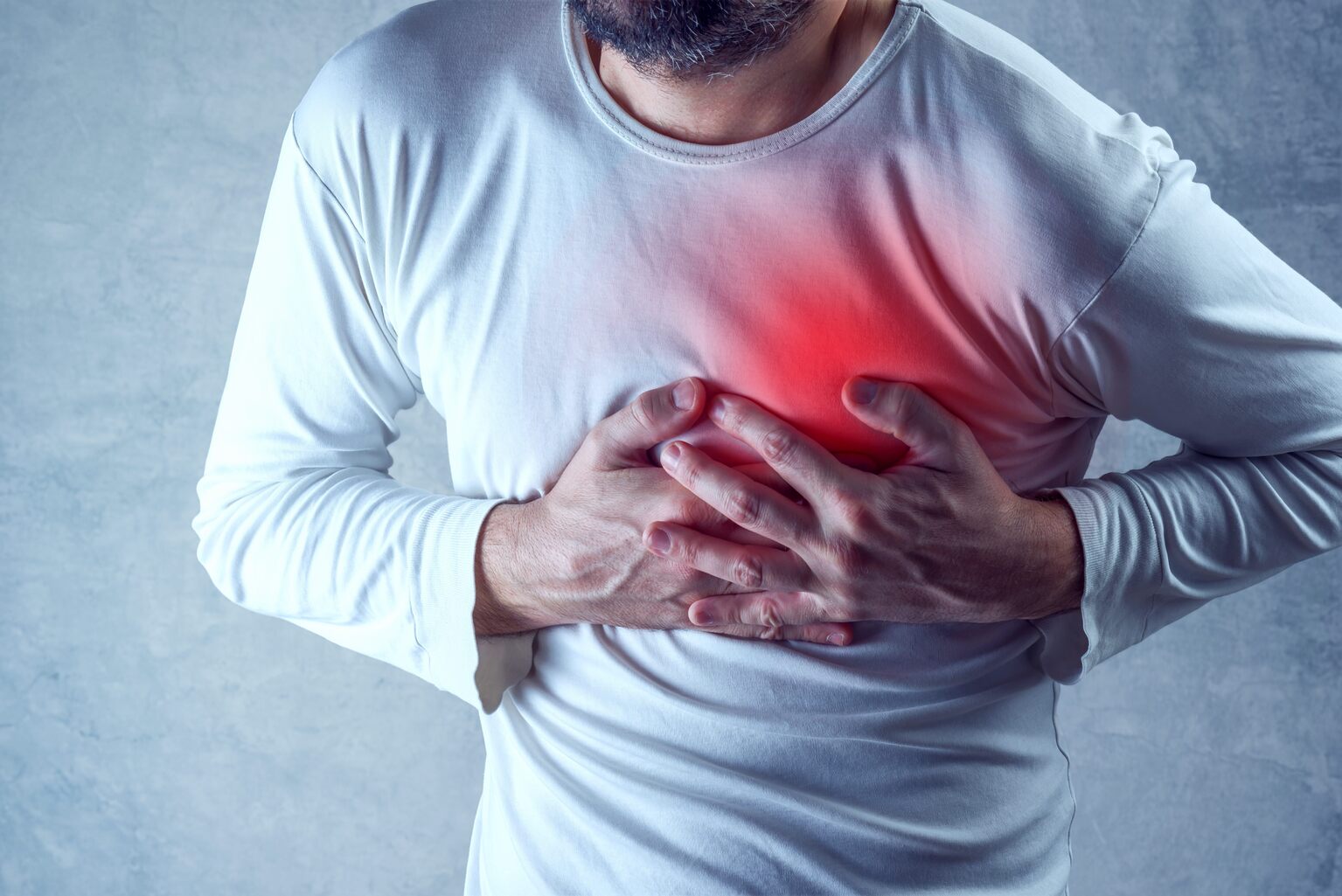Home>Misc>Featured>When Does Improvement In Cardiovascular Endurance Occur?


Featured
When Does Improvement In Cardiovascular Endurance Occur?
Modified: January 22, 2024
Improve cardiovascular endurance with featured exercises that have intensity equal to or greater than your current fitness level.
Introduction
Cardiovascular endurance is a key component of physical fitness that refers to the ability of the heart, blood vessels, and respiratory system to supply oxygen and nutrients to the muscles during sustained physical activity. It plays a vital role in improving overall health and athletic performance.
Having good cardiovascular endurance allows individuals to engage in activities for a prolonged period without becoming fatigued. Whether you’re a seasoned athlete or someone looking to improve your fitness level, focusing on improving cardiovascular endurance should be an essential part of your training routine.
By enhancing your cardiovascular endurance, you can reap numerous benefits, such as a lower risk of developing cardiovascular diseases, increased stamina, improved metabolism, enhanced lung capacity, and reduced stress levels.
While there are various factors that contribute to cardiovascular endurance, one crucial aspect to consider is the intensity of your workouts. The intensity of exercise is often measured by the level of effort or how hard you’re working during exercise.
This article explores the relationship between the intensity of exercise and cardiovascular endurance. We will discuss the optimal intensity for cardiovascular endurance improvement, the benefits of equal or greater intensity training, strategies to achieve such intensity, and common mistakes to avoid.
Definition of Cardiovascular Endurance
Cardiovascular endurance, also known as aerobic endurance or cardiorespiratory endurance, refers to the ability of the cardiovascular and respiratory systems to efficiently deliver oxygen-rich blood to the working muscles during sustained physical activity. It reflects the body’s ability to perform prolonged exercises involving large muscle groups, such as running, swimming, cycling, or brisk walking, without experiencing excessive fatigue.
While cardiovascular endurance is essential for athletes and individuals involved in sports, it also plays a crucial role in maintaining overall health and well-being. It ensures that vital organs receive a sufficient supply of oxygen, promotes efficient energy utilization, and improves the body’s ability to handle physical stress.
Cardiovascular endurance is measured by variables such as maximum oxygen consumption (VO2 max), which represents the maximum amount of oxygen that the body can utilize during exercise. A higher VO2 max indicates better cardiovascular endurance and suggests that an individual can sustain high-intensity activities for a more extended period.
Improving cardiovascular endurance involves enhancing the efficiency of the heart, lungs, and blood vessels. Regular aerobic exercise, such as jogging, swimming, or cycling, can help strengthen the heart muscle, increase lung capacity, and improve oxygen transportation throughout the body. Over time, consistent training leads to physiological adaptations that enhance cardiovascular endurance.
It’s important to note that cardiovascular endurance is different from muscular endurance, which focuses on the ability of specific muscles to exert force repeatedly or maintain a particular posture. While both types of endurance are essential, cardiovascular endurance primarily relates to the efficiency of the cardiovascular and respiratory systems.
Ultimately, developing and maintaining good cardiovascular endurance is crucial for overall health and fitness. It allows individuals to engage in daily activities with ease, improves physical performance, and reduces the risk of cardiovascular diseases.
Importance of Cardiovascular Endurance
Cardiovascular endurance is a critical component of physical fitness and plays a significant role in overall health and well-being. Here are some of the key reasons why improving cardiovascular endurance is important:
- Improved Heart Health: Regular cardiovascular exercise strengthens the heart muscle, making it more efficient in pumping blood. This reduces the risk of heart diseases, such as heart attacks, high blood pressure, and stroke.
- Increased Stamina and Energy Levels: Enhancing cardiovascular endurance allows individuals to perform physical activities for longer durations without feeling tired or out of breath. This increased stamina can greatly benefit athletes, individuals participating in endurance sports, and even everyday activities such as climbing stairs or carrying heavy objects.
- Enhanced Weight Management: Engaging in cardiovascular exercise helps burn calories, contributing to weight loss or weight management. Regular aerobic workouts, coupled with a balanced diet, can help achieve and maintain a healthy body weight.
- Improved Lung Function: Cardiovascular training helps increase lung capacity and efficiency, allowing for better oxygen intake and carbon dioxide removal. This leads to improved overall respiratory function and better endurance during physical activities.
- Reduced Stress and Mental Health Benefits: Engaging in cardio exercises releases endorphins, also known as “feel-good” hormones, which uplift mood and reduce stress levels. Regular exercise has been linked to improved mental health, reduced anxiety and depression, and enhanced overall well-being.
- Lower Risk of Chronic Diseases: Individuals with good cardiovascular endurance have a reduced risk of developing chronic conditions such as type 2 diabetes, certain types of cancer, and metabolic syndrome.
- Enhanced Longevity and Quality of Life: Regular cardiovascular exercise has been associated with increased lifespan and improved overall quality of life. It helps maintain physical independence and promotes a healthier and more active lifestyle as individuals age.
Overall, having good cardiovascular endurance is vital for maintaining a healthy, functional body and preventing numerous health issues. Incorporating regular cardiovascular exercise into your fitness routine can have profound effects on your physical and mental well-being, allowing you to lead a happier, more active life.
Factors Affecting Cardiovascular Endurance Improvement
Improving cardiovascular endurance involves a combination of factors that contribute to enhancing the efficiency of the heart, lungs, and blood vessels. Several key factors influence cardiovascular endurance improvement:
- Genetics: Genetic factors play a significant role in determining an individual’s baseline cardiovascular endurance. Some individuals naturally have a higher aerobic capacity and may find it easier to improve cardiovascular endurance compared to others.
- Age: Age affects cardiovascular endurance, as the efficiency of the cardiovascular and respiratory systems tends to decline with age. However, regular cardiovascular exercise can help offset age-related declines and improve endurance at any age.
- Training History: Previous exercise experience and training history can influence cardiovascular endurance improvement. Individuals who have a regular exercise routine or have engaged in endurance sports in the past may see faster improvements compared to beginners.
- Body Composition: Body composition, including muscle mass and body fat percentage, can impact cardiovascular endurance. Higher muscle mass can enhance endurance abilities, while excess body fat can affect performance due to added weight and increased energy demands.
- Current Fitness Level: The baseline fitness level of an individual can affect cardiovascular endurance improvement. Those who are relatively inactive may experience more substantial gains in endurance compared to individuals who are already moderately fit.
- Nutrition and Hydration: Proper nutrition and hydration are essential for optimal cardiovascular endurance improvement. Adequate intake of macronutrients and micronutrients, as well as staying hydrated, provides the body with the necessary energy and resources for endurance training and recovery.
- Training Program Design: The structure and design of the training program influence cardiovascular endurance improvement. Factors such as frequency, duration, and intensity of workouts, as well as the inclusion of various training methods, can impact the rate of progress.
- Rest and Recovery: Sufficient rest and recovery are crucial for cardiovascular endurance improvement. Overtraining and lack of adequate recovery can lead to decreased performance and increased risk of injury. Allowing enough time for rest and recovery between workouts is essential to optimize gains in endurance.
- Motivation and Consistency: Motivation and consistency are key factors that contribute to cardiovascular endurance improvement. Staying motivated, setting goals, and maintaining a consistent exercise routine are essential for sustained progress.
It’s important to note that the relative importance of each factor may vary from person to person. Understanding these factors can help individuals tailor their training approach and make necessary adjustments to optimize cardiovascular endurance improvement.
Relationship Between Intensity and Cardiovascular Endurance
The relationship between exercise intensity and cardiovascular endurance is crucial in determining the effectiveness of a training program. Exercise intensity refers to the level of effort or how hard an individual is working during physical activity. It plays a significant role in improving cardiovascular endurance.
Research has shown that cardiovascular endurance is positively impacted when exercise intensity is about equal to or greater than an individual’s aerobic threshold. The aerobic threshold is the point at which the body starts relying more on aerobic energy production systems (utilizing oxygen) rather than anaerobic energy systems (without oxygen).
Working at an intensity below the aerobic threshold may still provide benefits, but the improvements in cardiovascular endurance are generally more significant when the intensity is sufficiently challenging. Intensities that are too low may not stimulate the necessary physiological adaptations to enhance cardiovascular endurance.
Higher exercise intensities put greater demands on the cardiovascular and respiratory systems, leading to more significant improvements in aerobic capacity and endurance. It increases heart rate, ventilation, and oxygen consumption, stimulating the body to adapt by becoming more efficient in oxygen delivery and utilization.
The relationship between intensity and cardiovascular endurance is not linear. Working at too high of an intensity for prolonged periods can lead to fatigue, overtraining, and increased risk of injury. It is essential to find the optimal balance to elicit adaptations without pushing too far.
Individuals need to find their ideal training intensity, which can vary based on factors such as fitness level, goals, and exercise preference. It is recommended to work within a range that challenges the cardiovascular system, but still allows for sustainable effort without compromising form or risking overexertion.
Interval training, which alternates between high-intensity bursts and periods of lower intensity or rest, can be an effective method to improve cardiovascular endurance. This approach allows individuals to work at higher intensities while providing sufficient recovery to continue exercising.
It’s important to note that the relationship between intensity and cardiovascular endurance can be influenced by other factors, such as duration and frequency of training sessions. A well-rounded training program should incorporate a mix of intensity levels and training methods to optimize cardiovascular endurance improvement.
Optimal Intensity for Cardiovascular Endurance Improvement
Determining the optimal intensity for cardiovascular endurance improvement requires finding the right balance between challenging the cardiovascular system and avoiding excessive strain. The optimal intensity will vary depending on factors such as fitness level, goals, and individual preferences.
One commonly used method to gauge exercise intensity is to monitor heart rate. The target heart rate zone is typically considered to be between 50-85% of an individual’s maximum heart rate (MHR). The MHR is estimated by subtracting one’s age from 220. Working within this range allows for an effective cardiovascular workout without overexertion.
Another approach to determining intensity is the rating of perceived exertion (RPE) scale. This scale ranges from 6 to 20, with 6 being no exertion and 20 being maximum effort. Aim to work at an RPE of around 12-16, which corresponds to a moderate to hard effort level.
Interval training is an effective method to optimize intensity for cardiovascular endurance improvement. Alternating between higher intensity intervals and lower intensity or rest periods challenges the cardiovascular system while allowing for recovery. For example, a workout might involve alternating between 3 minutes of running at a faster pace and 2 minutes of walking or jogging at a relaxed pace.
It’s important to progress gradually when increasing intensity to avoid overtraining and injury. Start with lower-intensity workouts and progressively increase the intensity over time as fitness levels improve. Listen to your body and adjust the intensity as needed.
Individual goals and preferences also play a role in determining the optimal intensity for cardiovascular endurance improvement. If the goal is to enhance performance in a specific sport or activity, the intensity may need to be tailored to mimic the demands of that sport. Consult with a qualified fitness professional or coach to develop a personalized training plan that aligns with your goals.
Remember that maintaining consistency with your workouts is key to long-term cardiovascular endurance improvement. Focus on finding a sustainable intensity level that allows you to consistently engage in cardiovascular exercise. Strive for a balance between challenging workouts and adequate recovery to achieve optimal results.
Benefits of Equal or Greater Intensity Training
Training at equal or greater intensity levels for cardiovascular endurance improvement offers a range of benefits that can positively impact overall fitness and performance. Here are some key advantages of engaging in equal or greater intensity training:
- Improved Aerobic Capacity: Working at higher intensities challenges the cardiovascular system and improves aerobic capacity. This results in the ability to sustain exercise for longer periods without experiencing fatigue and breathlessness.
- Increased Calorie Burn: Greater intensity workouts require more energy, leading to increased calorie burn during and after exercise. This can support weight management goals and contribute to overall calorie expenditure.
- Enhanced Fat Burning: Higher intensity workouts stimulate the body to burn more fat as fuel. They create a metabolic response that increases post-exercise fat oxidation, helping to reduce body fat levels over time.
- Improved Muscle Endurance: Equal or greater intensity training challenges the muscles to work harder for sustained periods. This improves muscle endurance and delays the onset of muscle fatigue during prolonged aerobic activities.
- Increased Anaerobic Threshold: Training at higher intensities helps raise the anaerobic threshold—the point at which the body shifts to using a higher proportion of anaerobic energy sources. This allows individuals to work at higher intensities for longer durations before fatigue sets in.
- Heart Health Benefits: Higher intensity training strengthens the heart muscle, improves cardiac output, and enhances overall heart health. It can lower resting heart rate, increase stroke volume, and improve blood pressure regulation.
- Improved Oxygen Delivery and Utilization: Higher intensity exercise stimulates adaptations in the cardiovascular system, leading to better oxygen delivery and improved oxygen utilization by the working muscles. This promotes efficient energy production and enhances overall endurance capacity.
- Elevated Metabolic Rate: Higher intensity workouts can result in an elevated metabolic rate post-exercise, known as excess post-exercise oxygen consumption (EPOC). This means the body continues to burn calories at an increased rate even after the workout is finished.
- Time-Efficient Workouts: Working at higher intensities allows individuals to achieve the same or greater cardiovascular benefits in less time compared to lower intensity, longer duration workouts. This is particularly beneficial for those with limited time for exercise.
It’s important to note that equal or greater intensity training should be approached gradually and customized according to an individual’s fitness level and goals. It’s recommended to consult with a qualified fitness professional to design a safe and effective training plan that optimizes the benefits of equal or greater intensity training.
Strategies to Achieve Equal or Greater Intensity
Achieving equal or greater intensity during cardiovascular workouts requires strategic planning and implementation. Here are some effective strategies to help you reach and sustain higher intensity levels:
- Interval Training: Incorporate interval training into your workouts by alternating between periods of higher intensity exercise and active recovery or rest. This method boosts intensity and challenges the cardiovascular system while allowing for brief recovery intervals.
- Progressive Overload: Gradually increase the intensity of your workouts over time to continuously challenge your cardiovascular system. This can be done by increasing the duration, intensity, or frequency of your exercise sessions in a structured and progressive manner.
- Use Heart Rate Monitoring: Utilize heart rate monitors or wearable fitness trackers to monitor and track your heart rate during workouts. This can help ensure that you are working within the desired intensity range and making progress in your cardiovascular endurance.
- Implement High-Intensity Interval Training (HIIT): HIIT involves short bursts of intense exercise followed by short recovery periods. This method helps improve aerobic and anaerobic capacity, boost metabolism, and enhance cardiovascular endurance.
- Include Hills or Incline Training: Incorporate uphill running, cycling on an inclined surface, or incline intervals into your workouts. This increases the intensity by requiring your muscles and cardiovascular system to work harder against gravity.
- Vary Your Workout Modes: Engage in a variety of cardiovascular exercises, such as running, cycling, swimming, or rowing. Different modes of exercise work different muscle groups and challenge your cardiovascular system in unique ways, helping to achieve higher intensity levels.
- Work with a Trainer or Coach: Seek guidance from a qualified fitness professional or coach who can help design and monitor an effective training plan to achieve your desired intensity levels. They can provide proper guidance, technique cues, and track your progress along the way.
- Set and Track Goals: Set specific goals related to intensity levels and track your progress regularly. Having measurable goals can help you stay motivated and focused on achieving higher intensity workouts.
- Listen to Your Body: Pay attention to how your body feels during workouts. It’s essential to push yourself, but also know when to dial it back if you’re feeling overly fatigued or experiencing pain. Balancing intensity with proper rest and recovery is key for long-term progress.
Remember, gradually increasing intensity is crucial to avoid overexertion and minimize the risk of injury. It’s always recommended to start at a comfortable intensity and progressively challenge yourself as your fitness level improves.
Common Mistakes in Intensity Training
Intensity training plays a crucial role in improving cardiovascular endurance, but it’s important to avoid certain common mistakes that can hinder progress or increase the risk of injury. Here are some common mistakes to watch out for during intensity training:
- Starting Too Intense: Jumping into high-intensity workouts without a proper fitness base can lead to burnout, overtraining, or injury. Gradually increase intensity over time to allow your body to adapt and avoid pushing beyond your limits too soon.
- Not Warming Up Properly: Failing to warm up adequately before high-intensity workouts can increase the risk of muscle strains, joint injuries, and cardiovascular stress. Always warm up with dynamic movements and light aerobic exercise to prepare your body for the upcoming intensity.
- Ignoring Proper Form: Sacrificing proper form to maintain intensity levels can lead to inefficient movement patterns and increased risk of injury. Focus on maintaining good form and technique throughout your workouts, even when pushing to higher intensities.
- Overlooking Recovery: Neglecting rest and recovery can impede progress and increase the risk of overtraining. Allow your body sufficient time to recover between high-intensity workouts to prevent fatigue, muscle imbalances, and injuries.
- Not Listening to Your Body: Pushing through extreme fatigue or pain can be detrimental to your overall health and performance. Learn to listen to your body’s signals and adjust the intensity accordingly. It’s okay to have challenging workouts, but know when to scale back if needed.
- Ignoring a Balanced Approach: Solely focusing on high-intensity workouts without incorporating lower intensity or recovery sessions can hinder progress and increase the risk of overuse injuries. Balance your training program with a combination of intensity, volume, and active recovery sessions.
- Skipping Progression: Progressing too quickly without allowing time for adaptation can lead to plateauing or regression. Gradually increase intensity levels over time to continue challenging your cardiovascular system and maintaining progressive overload.
- Not Adjusting Intensity to Fitness Level: Failing to adjust intensity levels to your current fitness level can result in workouts that are either too easy or too challenging. Ensure your workouts are appropriately challenging for maximum benefits.
- Neglecting Rest Between Intervals: Not allowing sufficient rest between high-intensity intervals can compromise your ability to perform at a high intensity consistently. Ensure that you have enough rest time to recover and maintain the quality of each interval.
- Not Tracking Progress: Failing to track your progress can make it difficult to gauge improvements or make necessary changes to your intensity training plan. Keep a record of your workouts, including distance, time, intensity level, and perceived exertion, to monitor progress over time.
Avoiding these common mistakes and maintaining a balanced approach to intensity training will help you make consistent progress, minimize the risk of injury, and maximize the benefits of cardiovascular endurance improvement.
Conclusion
Cardiovascular endurance is a crucial component of physical fitness that plays a vital role in overall health and athletic performance. By focusing on improving cardiovascular endurance, individuals can experience numerous benefits, including a lower risk of cardiovascular diseases, increased stamina, improved metabolism, enhanced lung capacity, and reduced stress levels.
The intensity of exercise is a key factor in improving cardiovascular endurance. Working at equal or greater intensity levels challenges the cardiovascular system, leading to physiological adaptations that enhance endurance. It’s important to find the optimal balance, gradually increasing intensity over time, and listening to your body to avoid overexertion and injury.
Strategies such as interval training, progressive overload, heart rate monitoring, and incorporating a variety of workout modes can help individuals achieve equal or greater intensity during their cardiovascular workouts. However, it’s crucial to avoid common mistakes like starting too intense, neglecting recovery, ignoring form, and not adjusting the intensity to fitness levels.
By implementing these strategies and avoiding common pitfalls, individuals can efficiently improve their cardiovascular endurance, leading to improved overall fitness, performance, and quality of life. Whether you’re an athlete aiming to enhance your athletic capacity or an individual looking to improve your health and well-being, prioritizing cardiovascular endurance can have long-lasting benefits.
So, lace up your sneakers, find your optimal intensity, and embark on a journey to improve your cardiovascular endurance. Remember, consistency and gradual progression are key. With dedication and a well-structured training plan, you can achieve your goals and reap the rewards of a stronger, healthier cardiovascular system.









